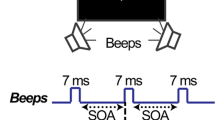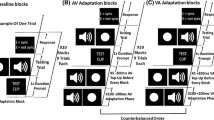Abstract
Music performance is characterized by complex cross-modal interactions, offering a remarkable window into training-induced long-term plasticity and multimodal integration processes. Previous research with pianists has shown that playing a musical score is affected by the concurrent presentation of musical tones. We investigated the nature of this audio-motor coupling by evaluating how congruent and incongruent cross-modal auditory cues affect motor performance at different time intervals. We found facilitation if a congruent sound preceded motor planning with a large Stimulus Onset Asynchrony (SOA −300 and −200 ms), whereas we observed interference when an incongruent sound was presented with shorter SOAs (−200, −100 and 0 ms). Interference and facilitation, instead of developing through time as opposite effects of the same mechanism, showed dissociable time-courses suggesting their derivation from distinct processes. It seems that the motor preparation induced by the auditory cue has different consequences on motor performance according to the congruency with the future motor state the system is planning and the degree of asynchrony between the motor act and the sound presentation. The temporal dissociation we found contributes to the understanding of how perception meets action in the context of audio-motor integration.


Similar content being viewed by others
References
Bangert M, Altenmüller EO (2003) Mapping perception to action in piano practice: a longitudinal DC-EEG study. BMC Neurosci 4:26
Bangert M, Peschel T, Schlaug G, Rotte M, Drescher D, Hinrichs H, Heinze HJ, Altenmüller E (2006) Shared networks for auditory and motor processing in professional pianists: evidence from fMRI conjunction. Neuroimage 30:917–926
Baumann S, Koeneke S, Schmidt CF, Meyer M, Lutz K, Jancke L (2007) A network for audio-motor coordination in skilled pianists and non-musicians. Brain Res 1161:65–78
Calvo-Merino B, Grèzes J, Glaser DE, Passingham RE, Haggard P (2006) Seeing or doing? Influence of visual and motor familiarity in action observation. Curr Biol 16:1905–1910
D’Ausilio A (2007) The role of the mirror system in mapping complex sounds into actions. J Neurosci 27:5847–5848
D’Ausilio A, Altenmüller E, Olivetti Belardinelli M, Lotze M (2006) Cross-modal plasticity of the motor cortex while listening to a rehearsed musical piece. Eur J Neurosci 24:955–958
Drost UC, Rieger M, Brass M, Gunter TC, Prinz W (2005a) Action-effect coupling in pianists. Psych Res 69:233–241
Drost UC, Rieger M, Brass M, Gunter TC, Prinz W (2005b) When hearing turns into playing: movement induction by auditory stimuli in pianists. Q J Exp Psychol A 58:1376–1389
Drost UC, Rieger M, Prinz W (2007) Instrument specificity in experienced musicians. Q J Exp Psychol A 60:527–533
Elbert T, Pantev C, Wienbruch C, Rockstroh B, Taub E (1995) Increased cortical representation of the fingers of the left hand in string players. Science 270:305–307
Fadiga L, Craighero L, D’Ausilio A (2009) Broca’s area in language, action, and music. Ann N Y Acad Sci 1169:448–458
Haueisen J, Knösche TR (2001) Involuntary motor activity in pianists evoked by music perception. J Cogn Neurosci 13:786–792
Hommel B, Müsseler J, Aschersleben G, Prinz W (2001) The theory of event coding (TEC): a framework for perception and action planning. Behav Brain Sci 24:849–878
Hund-Georgiadis M, von Cramon DY (1999) Motor-learning related changes in piano players and non-musicians revealed by functional magnetic-resonance signals. Exp Brain Res 125:417–425
Kaplan JT, Iacoboni M (2007) Multimodal action representation in human left ventral premotor cortex. Cogn Process 8:103–113
Keller PE, Knoblich G, Repp BH (2007) Pianists duet better when they play with themselves: on the possible role of action simulation in synchronization. Conscious Cogn 16:102–111
Koelsch S (2006) Significance of Broca’s area and ventral premotor cortex for music-syntactic processing. Cortex 42:518–520
Kuriki S, Kanda S, Hirata Y (2006) Effects of musical experience on different components of MEG responses elicited by sequential piano-tones and chords. J Neurosci 26:4046–4053
Lahav A, Saltzman E, Schlaug G (2007) Action representation of sound: audiomotor recognition network while listening to newly acquired actions. J Neurosci 27:308–314
Maidhof C, Rieger M, Prinz W, Koelsch S (2009) Nobody is perfect: ERP effects prior to performance errors in musicians indicate fast monitoring processes. PLoS ONE 4:e5032
Münte TF, Altenmüller E, Jäncke L (2002) The musician’s brain as a model of neuroplasticity. Nat Rev Neurosci 3:3473–3478
Murray MM, Camen C, Gonzalez Andino SL, Bovet P, Clarke S (2006) Rapid brain discrimination of sounds of objects. J Neurosci 26:1293–1302
Newman-Norlund RD, van Schie HT, van Zuijlen AM, Bekkering H (2007) The mirror neuron system is more active during complementary compared with imitative action. Nat Neurosci 10:817–818
Oldfield RC (1971) The assessment and analysis of handedness: the Edinburgh inventory. Neuropsych 9:97–113
Pantev C, Oostenveld R, Engelien A, Ross B, Roberts LE, Hoke M (1998) Increased auditory cortical representation in musicians. Nature 392:811–814
Pascual-Leone A, Nguyet D, Cohen LG, Brasil-Neto JP, Cammarota A, Hallett M (1995) Modulation of muscle responses evoked by transcranial magnetic stimulation during the acquisition of new fine motor skills. J Neurophysiol 74:1037–1045
Pizzamiglio L, Aprile T, Spitoni G, Pitzalis S, Bates E, D’Amico S, Di Russo F (2005) Separate neural systems for processing action- or non-action-related sounds. Neuroimage 24:852–861
Prinz W (1990) A common coding approach to perception and action. In: Neumann O, Prinz W (eds) Relationships between perception and action: current approaches. Springer, Berlin, pp 167–201
Prinz W (1997) Perception and action planning. Eur J Cogn Psych 9:129–154
Repp BH, Knoblich G (2004) Perceiving action identity: how pianists recognize their own performances. Psych Sci 15:604–609
Rieger M (2004) Automatic keypress activation in skilled typing. J Exp Psych: HPP 30:555–565
Rizzolatti G, Craighero L (2004) The mirror-neuron system. Ann Rev Neurosci 27:169–192
Rosenkranz K, Williamon A, Rothwell JC (2007) Motorcortical excitability and synaptic plasticity is enhanced in professional musicians. J Neurosci 27:5200–5206
Schlaug G, Jäncke L, Huang Y, Steinmetz H (1995) In vivo evidence of structural brain asymmetry in musicians. Science 267:699–701
Schütz-Bosbach S, Prinz W (2007) Perceptual resonance: action-induced modulation of perception. Trends Cogn Sci 11:349–355
Sebanz N, Bekkering H, Knoblich G (2006) Joint action: bodies and minds moving together. Trends Cogn Sci 10:70–76
Shahin A, Bosnyak DJ, Trainor LJ, Roberts LE (2003) Enhancement of neuroplastic P2 and N1c auditory evoked potentials in musicians. J Neurosci 23:5545–5552
Shahin AJ, Roberts LE, Chau W, Trainor LJ, Miller LM (2008) Music training leads to the development of timbre-specific gamma band activity. Neuroimage 41:113–122
Stewart L, Henson R, Kampe K, Walsh V, Turner R, Frith U (2003) Brain changes after learning to read and play music. Neuroimage 20:71–83
Wolpert DM, Kawato M (1998) Multiple paired forward and inverse models for motor control. Neural Net 11:1317–1329
Zatorre RJ, Chen JL, Penhune VB (2007) When the brain plays music: auditory-motor interactions in music perception and production. Nat Rev Neurosci 8:547–558
Author information
Authors and Affiliations
Corresponding author
Rights and permissions
About this article
Cite this article
D’Ausilio, A., Brunetti, R., Delogu, F. et al. How and when auditory action effects impair motor performance. Exp Brain Res 201, 323–330 (2010). https://doi.org/10.1007/s00221-009-2044-6
Received:
Accepted:
Published:
Issue Date:
DOI: https://doi.org/10.1007/s00221-009-2044-6




